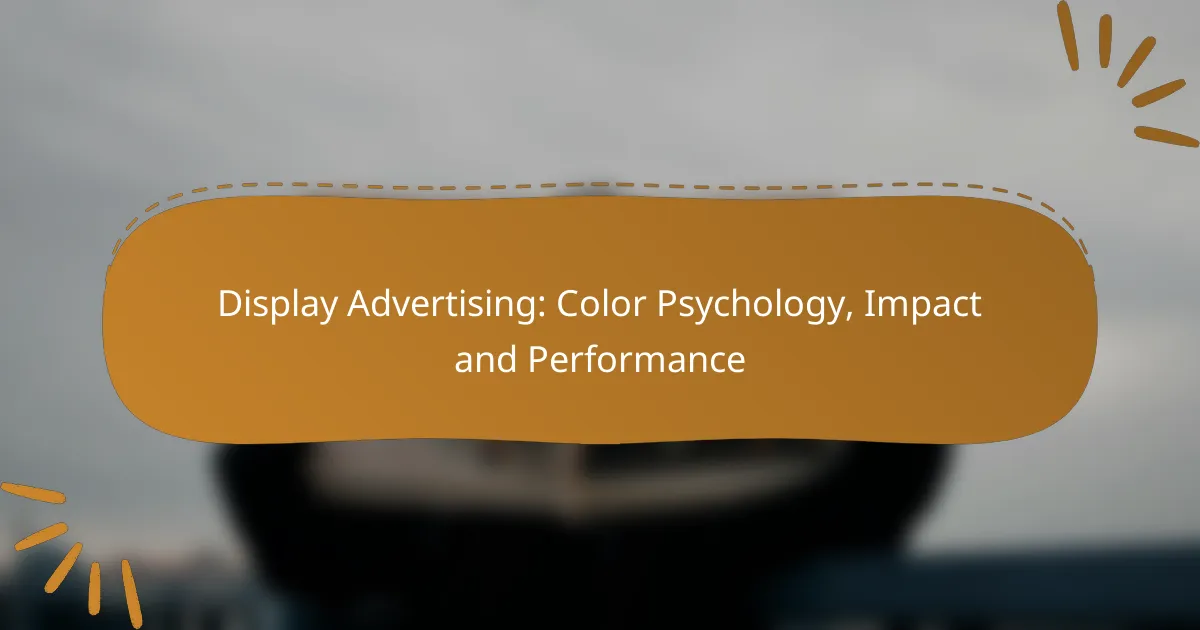Color psychology plays a crucial role in display advertising by shaping consumer perceptions and influencing purchasing decisions. By strategically selecting colors that evoke specific emotions, brands can enhance the effectiveness of their ad campaigns and improve engagement and conversion rates.

How does color psychology influence display advertising?
Color psychology significantly impacts display advertising by affecting how consumers perceive brands and make purchasing decisions. The right color choices can evoke specific emotions and associations, ultimately influencing the effectiveness of an ad campaign.
Emotional responses to colors
Different colors evoke distinct emotional responses that can enhance or detract from a brand’s message. For example, blue often conveys trust and reliability, making it popular among financial institutions, while red can evoke excitement or urgency, commonly used in clearance sales. Understanding these emotional triggers helps advertisers select colors that align with their desired brand image.
It’s essential to consider cultural differences in color perception. For instance, while white symbolizes purity in many Western cultures, it may represent mourning in some Eastern cultures. Advertisers should tailor their color choices to their target audience’s cultural context to avoid miscommunication.
Color associations in branding
Colors play a crucial role in brand identity, as they can create strong associations in consumers’ minds. Brands like Coca-Cola use red to symbolize energy and passion, while Starbucks employs green to represent growth and sustainability. Consistent use of specific colors can strengthen brand recognition and loyalty over time.
When developing a brand’s color palette, it’s beneficial to analyze competitors and industry standards. This can help identify color trends and differentiate a brand from others in the market. A well-thought-out color strategy can enhance a brand’s positioning and appeal.
Impact on consumer behavior
Color choices in display advertising can significantly influence consumer behavior, including click-through rates and conversion rates. Studies suggest that color can increase brand recognition by up to 80%, making it a vital factor in ad design. For instance, using contrasting colors for call-to-action buttons can improve visibility and encourage user interaction.
Advertisers should test different color combinations to determine what resonates best with their audience. A/B testing can reveal which colors lead to higher engagement and conversions, allowing marketers to refine their strategies based on real data. Avoiding overly complex color schemes can also help maintain clarity and focus in ads.

What are effective color combinations for display ads?
Effective color combinations for display ads can significantly enhance engagement and conversion rates. Utilizing contrasting colors, complementary pairings, and ensuring accessibility are key strategies to create visually appealing and impactful advertisements.
High-contrast color schemes
High-contrast color schemes involve using colors that are distinctly different from each other, which helps to draw attention and improve readability. For example, pairing dark text on a light background or vice versa can make key messages stand out. This approach is particularly effective in capturing the viewer’s eye quickly, making it suitable for call-to-action buttons.
When selecting high-contrast colors, consider using tools like Adobe Color or Coolors to visualize combinations. Aim for a contrast ratio of at least 4.5:1 for body text to ensure legibility, especially on mobile devices.
Complementary color pairings
Complementary color pairings consist of colors that are opposite each other on the color wheel, such as blue and orange or red and green. These combinations create a vibrant look that can evoke strong emotional responses, making them effective for branding and promotional campaigns. Using complementary colors can help highlight important elements within an ad.
To implement this strategy, choose one dominant color for the background and a complementary color for key elements like buttons or headlines. This not only enhances visual interest but also guides the viewer’s focus to essential information.
Color accessibility considerations
Color accessibility is crucial in ensuring that all viewers, including those with color vision deficiencies, can engage with your display ads. Use color combinations that provide sufficient contrast and avoid relying solely on color to convey important messages. For instance, pairing colors with different shapes or patterns can enhance understanding.
To improve accessibility, follow the Web Content Accessibility Guidelines (WCAG), which recommend a contrast ratio of at least 4.5:1 for normal text. Testing your ads with tools like the Color Contrast Analyzer can help identify potential issues before launch.

How can businesses measure the impact of color in ads?
Businesses can measure the impact of color in ads through various methods that assess consumer responses and engagement. By employing testing and analytics tools, companies can gather data on how different colors influence viewer behavior and ad performance.
A/B testing methodologies
A/B testing involves comparing two versions of an ad to determine which one performs better based on color choices. Businesses can create two ads that are identical except for the color scheme and then run them simultaneously to a similar audience. This method provides direct insight into how color affects viewer engagement and conversion rates.
When conducting A/B tests, ensure that the sample size is large enough to yield statistically significant results. Additionally, consider running tests over a sufficient time frame to account for variations in audience behavior, such as time of day or day of the week.
Analytics tools for performance tracking
Analytics tools like Google Analytics, Adobe Analytics, or specialized ad platforms can help track the performance of color variations in ads. These tools provide metrics such as click-through rates, conversion rates, and engagement levels, allowing businesses to see how different colors resonate with their audience.
Utilizing heatmaps can also be beneficial, as they visually represent where users focus their attention on an ad. This can help identify which colors draw the most interest and lead to higher interaction rates.
Key performance indicators (KPIs) to evaluate
When evaluating the impact of color in ads, focus on key performance indicators (KPIs) such as click-through rates (CTR), conversion rates, and engagement metrics. A higher CTR indicates that the color choice is effectively capturing attention, while conversion rates reveal how well the ad translates interest into action.
Additionally, monitor metrics like bounce rates and time spent on the landing page, as these can provide insights into how well the ad’s color aligns with the audience’s expectations and preferences. Regularly reviewing these KPIs will help refine color strategies for future campaigns.

What are common color strategies in display advertising?
Common color strategies in display advertising include maintaining brand color consistency, adapting to seasonal color trends, and aligning with target audience color preferences. These strategies help create effective visual communication that resonates with viewers and enhances brand recognition.
Brand color consistency
Brand color consistency is crucial for establishing a recognizable identity across all advertising platforms. Using the same color palette helps consumers associate specific colors with your brand, fostering trust and loyalty. For example, companies like Coca-Cola and Tiffany & Co. have successfully built their identities around distinct color schemes.
To ensure brand color consistency, create a style guide that outlines your primary and secondary colors, along with their respective hex codes. This guide should be shared with all team members involved in marketing to maintain uniformity across campaigns.
Seasonal color trends
Seasonal color trends can significantly influence consumer behavior and engagement. Colors associated with specific seasons, such as warm tones for autumn or pastels for spring, can evoke emotions that align with seasonal themes. For instance, using red and green during the holiday season can enhance festive appeal.
To leverage seasonal color trends effectively, monitor industry reports and design resources to identify popular colors each season. Incorporate these colors into your display ads to create timely and relevant campaigns that resonate with your audience.
Target audience color preferences
Understanding target audience color preferences is essential for maximizing ad performance. Different demographics may respond better to specific colors based on cultural associations or personal experiences. For example, blue is often associated with trust and reliability, making it popular among financial institutions.
Conduct surveys or focus groups to gather insights on your audience’s color preferences. Additionally, consider A/B testing different color schemes in your ads to determine which resonates best with your specific audience, allowing for data-driven decisions in future campaigns.

What are the prerequisites for effective color use in ads?
Effective color use in ads requires a deep understanding of the target audience and the emotional responses that colors evoke. By aligning color choices with demographic preferences and industry trends, advertisers can enhance engagement and drive performance.
Understanding target demographics
Identifying the target demographics is crucial for selecting colors that resonate with potential customers. Different age groups, genders, and cultural backgrounds often have varying associations with colors. For instance, younger audiences may respond positively to vibrant hues, while older demographics might prefer more subdued tones.
Consider conducting surveys or focus groups to gather insights on color preferences among your target audience. This data can guide your color choices, ensuring they align with the values and emotions of the demographic you aim to reach.
Researching industry color trends
Staying informed about industry color trends can significantly impact the effectiveness of your ads. Colors that are currently popular in your sector can enhance brand recognition and appeal. For example, tech companies often use blue to convey trust, while food brands might opt for red to stimulate appetite.
Regularly review competitor ads and industry reports to identify emerging color trends. Tools like color trend forecasting websites can also provide valuable insights. By adapting to these trends, you can create ads that feel relevant and contemporary to your audience.

What are the emerging trends in color psychology for advertising?
Emerging trends in color psychology for advertising focus on personalization and the integration of technology to enhance consumer engagement. Advertisers are increasingly using data-driven insights to tailor color schemes that resonate with individual preferences and cultural contexts.
Personalization and color adaptation
Personalization in advertising involves adjusting color choices based on consumer data, such as demographics and previous interactions. This approach can significantly enhance the effectiveness of campaigns, as colors that align with a target audience’s preferences can increase engagement and conversion rates.
For instance, a brand targeting a younger demographic might use vibrant colors like teal or coral, while a luxury brand may opt for more subdued tones like navy or gold. Testing different color palettes through A/B testing can help determine which resonates best with specific audience segments.
Use of augmented reality in color choices
Augmented reality (AR) is revolutionizing how brands utilize color in advertising by allowing consumers to visualize products in real-time. This technology enables users to see how different colors look in various environments, enhancing their decision-making process.
For example, a furniture retailer can use AR to let customers see how a couch in different colors would appear in their living room. This interactive experience not only engages consumers but also helps them feel more confident in their color choices, potentially leading to higher sales.
